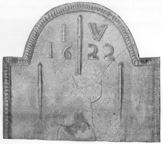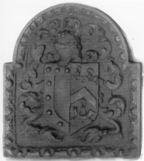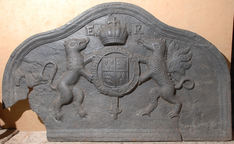-
1323
Description: Arched rectangular with broad fillet edges; arched rectangular inset with cavetto edging and armorial design in low relief: circular garter enclosing an ornate Tudor royal shield, surmounted by a crown; date inside top of arch; initials inside top corners of rectangle; a rose in each bottom corner of rectangle; inscription in a separate rectangular panel below, split by garter buckle.
Notes: An altered commercial copy of a Tudor fireback (no. 288) produced by F. Parkin & Sons (Exeter) and advertised in their 1972 catalogue. The width of the edges of the original fireback has been narrowed possibly to reduce weight and cost or for aesthetic reasons.
Copies of this fireback are known.
Inscription: 1553 / E R / HONV SOIT QVY MALE V PENCE / MOL LAND
Arms: Tudor royal - Edward VI
- Decoration tags:
- rectangular with round arch (shape)
- fillet (edging)
- whole carved pattern
- armorial
- royal
- text
Manufactured: in the mid- to late-20th century at Bonhay Foundry, Exeter in England.
Current location: not known.
- Attached to series:
- Edwardian royal armorial firebacks
-
288
Description: Arched rectangular with plain edges; arched rectangular inset with cavetto edging and armorial design in low relief: circular garter enclosing an ornate Tudor royal shield, surmounted by a crown; date inside top of arch; initials inside top corners of rectangle; a rose in each bottom corner of rectangle; inscription in a separate rectangular panel below, split by garter buckle.
Notes: The earliest dated fireback in the English style. Molland was a Devon manor belonging to the Courtenay family. Noted as having been at Wells Deanery, Somerset, in 1845; a variant without the motto, the existence of which was noted in 1840, was illustrated by Llewellin (1863). The west country source for both of these firebacks offers the possibility of an origin in those parts.
Copies of this fireback are known.
Inscription: 1553 / E R / HONV SOIT QVY MALE V PENCE / MOL LAND
Arms: Tudor royal - Edward VI
- Decoration tags:
- rectangular with round arch (shape)
- none (edging)
- whole carved pattern
- armorial
- royal
- text
Manufactured: in 1553 .
Current location: Davington Priory, Priory Road, Faversham, Kent, England.
Citation: Collier, C. V., 1897, 'Coats of Arms in Kent Churches', Archaeologia Cantiana, 22, pp. 190-1.
- Attached to series:
- Edwardian royal armorial firebacks
- Tudor royal armorial firebacks
-
941
Description: Arched rectangular shape; scalloping within wide fillet edging; shield, knight's helm, crest and mantling; date split either side of armorial.
Notes: The arms are of Kyrle (vert, a chevron between three fleurs de lys or; crest: on a mount vert a hedgehog or) of Much Marcle, Herefordshire, quartered with Abrahall (azure three hedgehogs or; the fess appears to be erroneous) and Warnecombe (sable, on a fess dancetty argent between three bezants each charged with an escallop of the field as many lions rampant argent armed and langued gules). The second part of the date appears to have been altered by hand for the present casting as the style of lettering for the final two numerals is crude compared with the first two. Sir John Kyrle may have operated the iron furnace at Whitchurch, between Monmouth and Ross on Wye; the style of the carving is the same as on two other firebacks in the same county. It is apparent, from another example, that this fireback has either been broken and repaired, or deliberately reduced in height. Originally the mantling of the helm extended further down, ending in tassels on each side, making the height of the fireback approximately equal to its width. An early photograph of the Fawley fireback, taken by Alfred Watkins, the Herefordshire antiquarian, shows the division of the two parts more clearly (Herefordshire Record Office, AW339b). A copy of the original, un-reduced fireback has been noted with the date 1685 in the distinctive numerals seen on firebacks from Flaxley Furnace, Gloucestershire.
Copies of this fireback are known.
Inscription: 16 20
Arms: Kyrle quartering Abrahall and Warnecombe
- Decoration tags:
- rectangular with round arch (shape)
- fillet with scalloping (edging)
- whole carved pattern
- individual numbers
- armorial
- text
Manufactured: in 1620 possibly at Whitchurch Furnace in the Herefordshire area of England.
Current location: in private hands, Fawley, Herefordshire, England.
- Attached to series:
- Personal armorial firebacks
- Herefordshire armorial series
-
66
Description: Quasi-arched rectangular shape; twisted rope edging on top and sides of rectangle, and separately around arch; the rope ends extend beyond both ends of the top edge; vertical rope lengths, to full height, inside left and right edges; rope crosses in arch and in upper centre of rectangle.
Notes: Probably an early vernacular example of a design mimicking the ‘Palladian’ style. The crosses suggest Christian significance.
- Decoration tags:
- rectangular with round arch (shape)
- rope (edging)
- simple stamps
- apotropaic
Manufactured: in the mid- to late-16th century in the Weald area of England.
Current location: in private hands, Fernhurst, West Sussex, England.
- Attached to series:
- Rope design firebacks
-
297
Description: Arched rectangular shape; wide fillet edging with alternate bead and pellet on top and sides, the pellets rotated over the arch where they are separated in triplets by blocks; shield, helm, crest and mantling of Saunderson, with a strapwork compartment at the bottom; initials split by wreath; date split by crest.
Notes: The arms are probably those of Thomas Saunderson of Gainsborough (c.1568- before 1642).
Copies of this fireback are known.
Inscription: 16 19 / T S
Arms: Thomas Saunderson of Gainsborough
- Decoration tags:
- rectangular with round arch (shape)
- fillet (edging)
- whole carved pattern
- armorial
Manufactured: in 1619 in England.
Current location: Museum of Lincolnshire Life, Burton Road, Lincoln, Lincolnshire, England.
(part of the Lincolnshire County Council museum group)
- Attached to series:
- Personal armorial firebacks
-
1284
Description: Arched rectangular shape; gadrooned edging (top and sides); initials, in separate stamps, at top of arch; date probably in separate stamps, below; spindle used as a stamp repeated three times, one between date and initial stamps, the other two below to left and right.
Notes: The same base board and spindle have been used for other firebacks of the same period. A similar casting (no. 299) has the 'W' in a slightly different position. Formerly at Warnham Court, Sussex.
Inscription: I W / 16 22
- Decoration tags:
- rectangular with round arch (shape)
- gadrooned (edging)
- simple stamps
- individual letters
- individual numbers
- text
- objects
Manufactured: in 1622 possibly at Cuckfield Furnace in the Weald area of England.
Current location: not known.
Citation: Gardner, J. S., 1898, 'Iron Casting in the Weald', Archaeologia, 56, 1, pp. 133-164.
- Attached to series:
- Spindle series
- Spindle/distaff firebacks
-
900
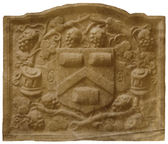 ? x ? mm
? x ? mmDescription: Low stepped-arched rectangular shape; ovolo-moulded edging; central shield backed by a cartouche, surrounded by grape bunches, vines and leaves.
Notes: Arms of the Worshipful Company of Vintners - sable, a chevron between three tuns argent - were granted in 1442. From a photograph in the J. Starkie Gardner Collection, Victoria & Albert Museum, Archive of Art and Design (AAD/2014/8).
Arms: Worshipful Company of Vintners
- Decoration tags:
- rectangular with round arch (shape)
- ovolo (edging)
- whole carved pattern
- armorial
- plants
- objects
Manufactured: in the early- to mid-17th century in England.
Current location: not known.
- Attached to series:
- Livery company firebacks
-
1281
Description: Composite; arched rectangular shaped, armorial fireback, cavetto edging, with Stuart Royal arms, garter, supporters, crown and motto, and 1639 date above crown; this overlies a rectangular plate with fillet edging; top centre in the space each side of the central shield, an initial letter - W to left, C to right.
Notes: One of several variants using a fireback with the English Stuart royal arms, the date probably altered according to when it was cast. The original date of the fireback was probably 1619. Garth's Auctioneers, Columbus, OH, 3 Jan 2015, lot 2347 ($300).
Inscription: 1639 / W C
Arms: English Stuart royal
- Decoration tags:
- rectangular with round arch (shape)
- fillet (edging)
- carved stamps
- whole carved pattern
- composite
- extension panels
- heraldic
- armorial
- royal
- text
Manufactured: in 1639 possibly in the Forest of Dean area of England.
Current location: not known.
-
898
Description: Arched rectangular; ovolo-moulded egg and dart edging; shield surmounted by helm and indistinct crest, with elaborate mantling.
Notes: Blazon (bordure bezanty impaling a chevron between three bugle horns) is unidentified. The date of c.1730 suggested by Gentle and Feild is unlikely to be correct.
Arms: Not known
- Decoration tags:
- rectangular with round arch (shape)
- ovolo, egg and dart (edging)
- whole carved pattern
- armorial
Manufactured: in the early- to mid-17th century in England.
Current location: not known.
- Attached to series:
- Personal armorial firebacks
-
303
Description: Rectangle with curved shoulders and low arch joined with concave curves; fillet and ogee moulded edging; central Tudor royal shield surrounded by garter, with crown above and lion and dragon supporters; royal initials either side of crown.
Notes: Damaged on bottom left corner; the garter motto includes ‘EQVI’ instead of ‘HONI’, making it meaningless; possibly ‘EQVI’ was a mis-transcription of ‘HONI’; the crown is distinctly continental in form; a much-copied fireback. Previously at Hoarthorns Farm, West Dean, Gloucestershire, where another fireback of the same design was recovered from a pond and is now at the Forestry Commission camp site at Christchurch, near Coleford.
Copies of this fireback are known.
Inscription: E R / EQVI : SOIT : QVI : MAL : Y : PENSE
Arms: Tudor royal - Edward VI or Elizabeth I
- Decoration tags:
- rectangular with round arch (shape)
- fillet and ogee (edging)
- whole carved pattern
- planklines
- armorial
- royal
- text
Manufactured: in the mid- to late-16th century in England.
Current location: Gloucester Folk Museum, Westgate street, Gloucester, Gloucestershire, England.
Museum number: GLRCM:F03526 (part of the Gloucester Museums museum group)
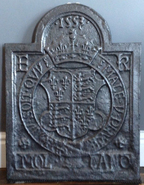


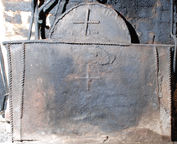
.jpg)
